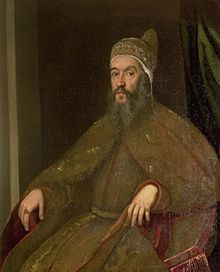Alvise Mocenigo I.


Alvise Mocenigo I (born October 26, 1507 in Venice ; † June 4, 1577 there ) was the 85th Doge of Venice from 1570 to 1577 .
family
Alvise Mocenigo I came from the branched Mocenigo family , which provided a total of seven doges : Tommaso Mocenigo (1414–1423), Pietro Mocenigo (1474–1476), Giovanni Mocenigo (1478–1485), Alvise Mocenigo I, Alvise Mocenigo II. (1700-1709), Alvise Mocenigo III. (1722-1732) and Alvise Mocenigo IV. (1763-1778).
Life
Mocenigo was born on October 26, 1507, the first of five sons of the procurator of San Marco Tommaso Mocenigo. He received a good and thorough education. He distinguished himself above all in the diplomatic service and in the internal administration of the republic. Alvise Mocenigo was defeated in the election of 1559 against Priuli, in the election of 1570 he was able to prevail against his later successors Sebastiano Venier and Nicolò da Ponte .
Mocenigo was married to Loredana Marcello, a woman with literary and natural science education. Since he had no descendants, he bequeathed his fortune to his brothers, with the stipulation that the male descendants should receive the name Alvise.
The Doge's Office
The Dogat Mocenigos was characterized by armed conflicts with the Ottoman Empire, by alliances with the Pope , France and Spain on the one hand and political tensions with the same powers on the other, as well as by the economic decline of the lagoon city and a decimation of the population of Venice and the Terraferma by typhus and plague .
In his first year in office, on August 3, 1571, the city of Famagusta in Cyprus fell to the Turks. The city's defender, Marcantonio Bragadin , was brutally executed. As a result, on the orders of the Sultan, Cyprus was settled by Turks from Anatolia.
Lepanto and the consequences
In the course of the conflict with the Turks, they had obstructed the Venetian grain supply. In 1571 there was a naval battle between the Holy League of Venice, Spain and the Pope in the Gulf of Patras , in which the Turks were defeated at Lepanto . At first sight the Turks were the losers and Venice was the winners. But while the Turks succeeded in further consolidating their maritime power in the eastern Mediterranean, Venice had lost the rich Cyprus and paid an additional 300,000 ducats in three annual installments to the loser of Lepanto in order to secure his trading privileges. Nevertheless, Venice recorded severe losses in the oriental trade, as the Sultan favored Dutch, French and English merchants alike. Due to the simultaneously growing overseas trade via the Atlantic ports, Venice was finally pushed into a marginal economic position.
State visit of King Henry III. from France
Despite the economic misery and the empty state coffers, Venice once again displayed all its splendor on the occasion of the state visit of the young French king in 1574. The background was the idea of winning the king over to an alliance. The King was received by the Doge on the Bucintoro . All of Venice's well-known artists, such as Titian , Palladio , Veronese and Tintoretto, were involved in the decoration of the festivities; the banquet's sugar decorations came from Sansovino .
The plague
In 1575 and 1576 the plague broke out again in Italy. The Terraferma lost a quarter of its population. The consequences of the plague for Venice were devastating. The city's committees were almost no longer able to work because of the high losses among their members. A prominent victim was Titian, who fell victim to the epidemic at the age of 100. In their distress, the Venetians vowed to build a church in 1576 if the city would be redeemed from the plague. The votive church Il Redentore was built on the Giudecca between 1577 and 1592 according to a design by Palladio .
Mocenigo died on June 4th, 1577, his death had been requested by the Venetians, according to reports from contemporaries - obviously in the hope of better times under a successor.
photos
- Jacopo Tintoretto : Ritratto del doge Alvise Mocenigo (Portrait of the Doge Alvise Mocenigo). 1570/73, since 1812 in the Gallerie dell 'Accademia , Venice.
- Jacopo Tintoretto: The Doge Alvise Mocenigo is presented to the Redeemer. Metropolitan Museum of Art , New York.
Tomb
The double tomb for Alvise and his wife Loredana is in the church of San Zanipolo . It was erected on the west wall in the nave of the church, in the immediate vicinity of the monument to Pietro Mocenigo . The monument made of Istrian stone , designed and executed by Giovanni Girolamo Grapiglia and Francesco Contino, has a two-storey structure. On the second floor there are the two sarcophagi with the reclining figures on the side of a figure of the blessing Christ. The church portal is incorporated into the architecture of the monument.
literature
- Andrea da Mosto: I Dogi di Venezia. Florence 1983.
- Helmut Dumler: Venice and the Doges. Düsseldorf 2001.
Web links
| predecessor | Office | successor |
|---|---|---|
| Pietro Loredan |
Doge of Venice 1570 - 1577 |
Sebastiano Venier |
| personal data | |
|---|---|
| SURNAME | Mocenigo I., Alvise |
| BRIEF DESCRIPTION | Doge of Venice (1570–1577) |
| DATE OF BIRTH | October 26, 1507 |
| PLACE OF BIRTH | Venice |
| DATE OF DEATH | June 4, 1577 |
| Place of death | Venice |

